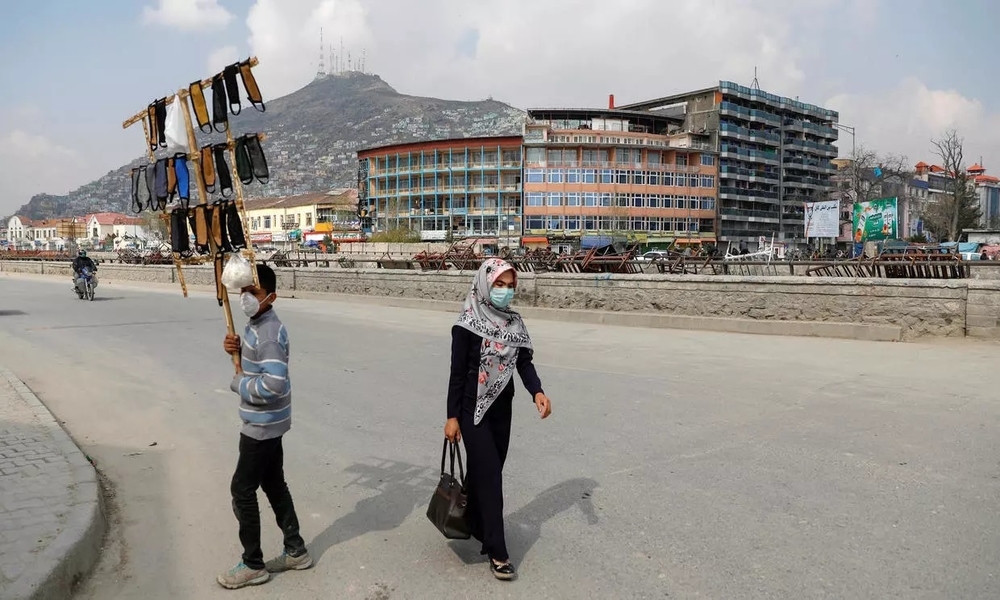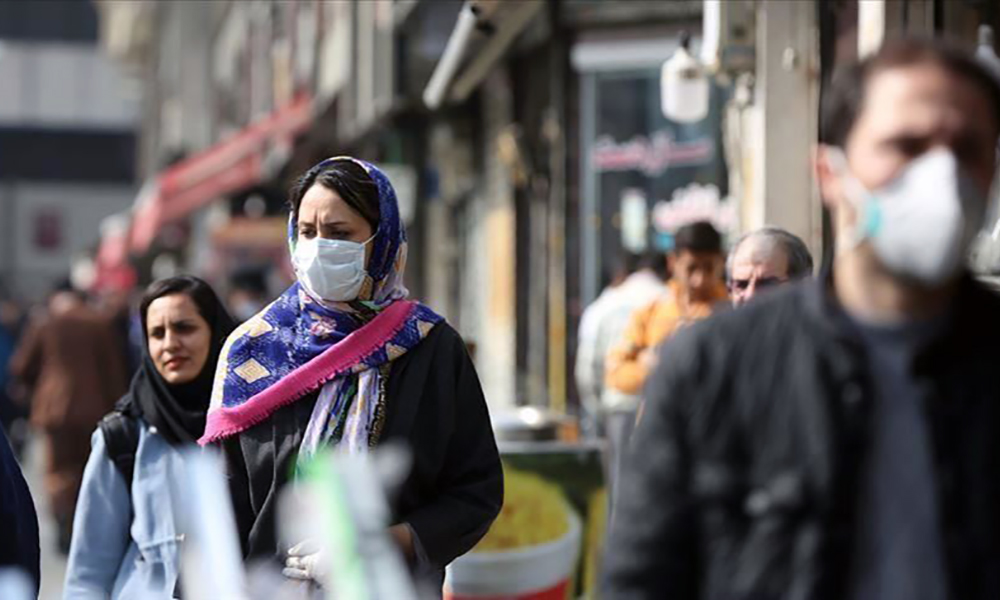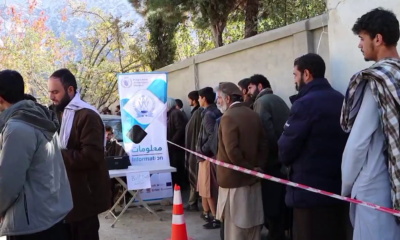COVID-19
Afghanistan Coronavirus updates: 369 deaths, total cases 2,0917

At least 12 people have died of the Coronavirus in Afghanistan in the past 24 hours, bringing the total fatalities to 369, the Ministry of Public Health said.
According to the ministry, seven people in Kabul, four people in Helmand, and one person died in Maidan Wardak provinces who were suffering COVID-19.
Meanwhile, the ministry said that 575 people were tested positive for the Coronavirus in the past 24 hours.
The cases were recorded as follow: Kabul 193, Herat 151, Kandahar 39, Paktia 7, Nangarhar 23, Badghis 13, Takhar 5, Logar 22, Nimroz 10, Maidan Wardak 7, Parwan 13, Laghman 3, Helmand 39, Kunar 26, Ghor 10, Zabul 8, Badakhshan 1, and Daikundi 5.
It brings the total affected people to 20,917 in Afghanistan, the ministry added.
The ministry added that 329 people have been recovered and fully discharged from the hospitals in the past 24 hours. So far, 2,171 people have been recovered from the virus.
It comes as the government announced restriction guidance for the next three months.
According to the guidance wearing masks in public is mandatory and any gathering of more than 10 people is and funeral ceremonies and parties are totally banned.
Party wedding halls, hotels, gymnasiums, auditoriums, parks, and other public sites including all educational centers would remain closed for the next three months. Under the plan, all educational centers could continue their activities via online platforms.
Meanwhile, a number of citizens who have visited the Coronavirus Centers to take the tests for the virus, in the capital and the provinces, say that the process has been stopped for several days now and the health authorities have rejected them due to the lack of diagnostic kits.
COVID-19
WHO declares end to COVID global health emergency

The World Health Organization said Friday that COVID-19 no longer qualifies as a global emergency, marking a symbolic end to the devastating coronavirus pandemic that triggered once-unthinkable lockdowns, upended economies and killed millions of people worldwide.
The announcement, made more than three years after WHO declared the coronavirus an international crisis, offers some relief, if not an ending, to a pandemic that stirred fear and suspicion, hand-wringing and finger-pointing across the globe, AP reported.
The U.N. health agency’s officials said that even though the emergency phase was over, the pandemic hasn’t finished, noting recent spikes in cases in Southeast Asia and the Middle East.
WHO says thousands of people are still dying from the virus every week, and millions of others are suffering from debilitating, long-term effects.
“It’s with great hope that I declare COVID-19 over as a global health emergency,” WHO Director-General Tedros Adhanom Ghebreyesus said.
“That does not mean COVID-19 is over as a global health threat,” he said, warning that new variants could yet emerge. Tedros noted that while the official COVID-19 death toll was 7 million, the real figure was estimated to be at least 20 million.
Tedros said the pandemic had been on a downward trend for more than a year, acknowledging that most countries have already returned to life before COVID-19.
He bemoaned the damage that COVID-19 had done to the global community, saying the pandemic had shattered businesses, exacerbated political divisions, led to the spread of misinformation and plunged millions into poverty.
When the U.N. health agency first declared the coronavirus to be an international crisis on Jan. 30, 2020, it hadn’t yet been named COVID-19 and there were no major outbreaks beyond China.
More than three years later, the virus has caused an estimated 764 million cases globally and about 5 billion people have received at least one dose of vaccine.
In the U.S., the public health emergency declaration made regarding COVID-19 is set to expire on May 11, when wide-ranging measures to support the pandemic response, including vaccine mandates, will end. Many other countries, including Germany, France and Britain, dropped most of their provisions against the pandemic last year.
When Tedros declared COVID-19 to be an emergency in 2020, he said his greatest fear was the virus’ potential to spread in countries with weak health systems.
Most recently, WHO has struggled to investigate the origins of the coronavirus, a challenging scientific endeavor that has also become politically fraught.
COVID-19
COVID-19 in Iran: Nearly 900 new cases, 24 deaths recorded

The Iranian health ministry announced on Sunday that more than 890 new cases of COVID-19 have been identified across the country during the past 24 hours, adding that 24 patients have died in the same period of time, Fars News Agency reported.
"A sum of 891 new patients infected with COVID-19 have been identified in the country based on confirmed diagnosis criteria during the past 24 hours," the Iranian Health Ministry's Public Relations Center said on Sunday, adding, "454 patients have been hospitalized during the same time span."
The ministry’s public relations center said 611 people infected with COVID-19 are in critical condition.
COVID-19
China says 200 million treated, pandemic ‘decisively’ beaten

China says more than 200 million of its citizens have been diagnosed and treated for COVID-19 since it lifted strict containment measures beginning in November.
With 800,000 of the most critically ill patients having recovered, China has “decisively beaten” the pandemic, according to notes from a meeting of the ruling Communist Party’s all-powerful Politburo Standing Committee presided over by President and party leader Xi Jinping, AP reported.
China enforced some of the world’s most draconian lockdowns, quarantines and travel restrictions and still faces questions about the origins of the virus that was first detected in the central Chinese city of Wuhan in late 2019. Heavy-handed enforcement prompted rare anti-government protests and took a heavy toll on the world’s second-largest economy.
The official Xinhua News Agency quoted Xi as saying that policies to control the outbreak had been “entirely correct.” The abrupt lifting in November and December of the “zero COVID” policy that had sought to eliminate all cases of the virus led to a surge in infections that temporarily overwhelmed hospitals.
Case numbers have since peaked and life has largely returned to normal, although international travel in and out of China has yet to return to pre-pandemic levels.
China is now transitioning to a post-pandemic stage after a fight against the outbreak that was “extraordinary in the extreme,” Xinhua said.
The government will continue to “optimize and adjust prevention and control policies and measures according to the times and situations with a strong historical responsibility and strong strategic determination,” Xinhua said.
-

 Sport5 days ago
Sport5 days agoATN to broadcast exciting 2025 ICC Champions Trophy live in Afghanistan
-

 Sport5 days ago
Sport5 days agoRashid Khan returns to Afghanistan test squad for Zimbabwe series
-

 Sport5 days ago
Sport5 days agoLanka T10: Jaffna Titans maintain unbeaten streak with 4th win
-

 Latest News5 days ago
Latest News5 days agoIslamabad now wants talks with Kabul, says KP chief minister
-

 World5 days ago
World5 days agoTrump and Netanyahu discuss Gaza hostages and Syria, Israeli PM says
-

 International Sports4 days ago
International Sports4 days agoWinners of The Best FIFA Football Awards 2024 to be revealed Dec. 17
-

 Latest News4 days ago
Latest News4 days agoAfghanistan’s harsh winter intensifies struggles for vulnerable families: WFP
-

 Latest News5 days ago
Latest News5 days agoEU allocates 19.8 million euros to promote economic growth in Afghanistan

























